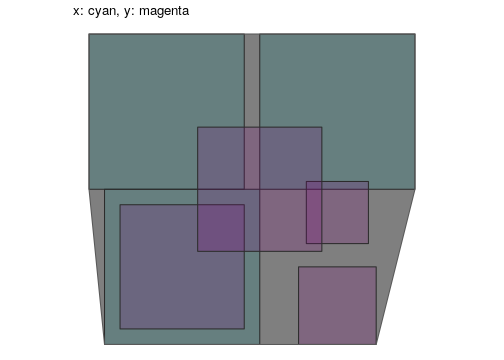class: center, middle, inverse, title-slide # Working with Geospatial Data ## Geometric operations ### Ben Baumer ### SDS 192</br>April 13th, 2020</br>(<a href="http://beanumber.github.io/sds192/lectures/mdsr_geo_08-intersections.html" class="uri">http://beanumber.github.io/sds192/lectures/mdsr_geo_08-intersections.html</a>) --- class: center, middle, inverse # Spatial operations --- ## Geometric operations .footnote[https://r-spatial.github.io/sf/articles/sf3.html#geometrical-operations-1] .pull-left[ - Combine spatial layers - `st_intersection()`, `st_union()`, `st_difference()`, `st_sym_difference()` - Return another `sf` object OR - Detect connections/overlaps in spatial layers - `st_intersects()`, `st_touches()`, `st_within()`, etc. - Return `TRUE/FALSE` ] -- .pull-right[ <!-- --> ] --- ## Intersection of two layers .pull-left[ ```r base + geom_sf( * data = st_intersection(x, y), fill = "black", alpha = 0.5 ) ``` ] .pull-right[  ] --- ## Union of two layers .pull-left[ ```r base + geom_sf( * data = st_union(x, y), fill = "black", alpha = 0.5 ) ``` ] .pull-right[  ] --- ## Combine multiple operations .pull-left[ ```r base + geom_sf( data = x %>% st_union(y) %>% st_combine() %>% * st_convex_hull(), fill = "black", alpha = 0.5 ) ``` ] .pull-right[  ] --- background-image: url(https://r-spatial.github.io/sf/articles/sf3_files/figure-html/unnamed-chunk-29-1.png) background-size: contain --- ## Detection: Do `x` and `y` intersect? ```r st_intersects(x, y) ``` ``` ## Sparse geometry binary predicate list of length 3, where the predicate was `intersects' ## 1: 1, 3 ## 2: 2, 3 ## 3: 3 ``` ```r st_intersects(x, y, sparse = FALSE) ``` ``` ## [,1] [,2] [,3] [,4] ## [1,] TRUE FALSE TRUE FALSE ## [2,] FALSE TRUE TRUE FALSE ## [3,] FALSE FALSE TRUE FALSE ``` ```r st_intersects(y, x) ``` ``` ## Sparse geometry binary predicate list of length 4, where the predicate was `intersects' ## 1: 1 ## 2: 2 ## 3: 1, 2, 3 ## 4: (empty) ``` .footnote[https://r-spatial.github.io/sf/articles/sf3.html#binary-logical-operations-] --- ## Example: lines inside a boundary - Q: Streams *pass through* the MacLeish property. Can we find only the parts of those streams within the boundary? -- ```r library(macleish) boundary <- macleish_layers %>% pluck("boundary") streams <- macleish_layers %>% pluck("streams") ``` -- ```r nrow(streams) ``` ``` ## [1] 13 ``` ```r interior_streams <- boundary %>% st_intersection(streams) nrow(interior_streams) ``` ``` ## [1] 11 ``` --- ## Example: interior streams ```r library(leaflet) mac <- leaflet() %>% addTiles() %>% addPolygons(data = boundary, color = "black") mac %>% addPolylines(data = streams) %>% addPolylines(data = interior_streams, color = "red") ``` <div id="htmlwidget-bc74ce11b65545703094" style="width:504px;height:360px;" class="leaflet html-widget"></div> <script type="application/json" data-for="htmlwidget-bc74ce11b65545703094">{"x":{"options":{"crs":{"crsClass":"L.CRS.EPSG3857","code":null,"proj4def":null,"projectedBounds":null,"options":{}}},"calls":[{"method":"addTiles","args":["//{s}.tile.openstreetmap.org/{z}/{x}/{y}.png",null,null,{"minZoom":0,"maxZoom":18,"tileSize":256,"subdomains":"abc","errorTileUrl":"","tms":false,"noWrap":false,"zoomOffset":0,"zoomReverse":false,"opacity":1,"zIndex":1,"detectRetina":false,"attribution":"© <a href=\"http://openstreetmap.org\">OpenStreetMap<\/a> contributors, <a href=\"http://creativecommons.org/licenses/by-sa/2.0/\">CC-BY-SA<\/a>"}]},{"method":"addPolygons","args":[[[[{"lng":[-72.6813326056311,-72.6810786061597,-72.6811116175942,-72.6811557558542,-72.6811915736354,-72.6812188754693,-72.6812375123515,-72.6812473825557,-72.6812592825027,-72.6812660667621,-72.6812792447276,-72.6812987265098,-72.6813243792104,-72.6818090312404,-72.6818666853001,-72.6819172308122,-72.6819605646939,-72.6819965985629,-72.6820684524584,-72.6821180597865,-72.6821468942021,-72.6777712673739,-72.6776816557632,-72.6776288835332,-72.6769558182033,-72.6768553667623,-72.677054589315,-72.6770556526886,-72.6770347668263,-72.6769444002422,-72.6768110892832,-72.6764870955702,-72.6764777555354,-72.6764575851864,-72.6763516248554,-72.676325466473,-72.6763031150938,-72.6761983754138,-72.6760278090534,-72.6759871105514,-72.6759388763087,-72.6759352367062,-72.6759335399706,-72.675937556106,-72.6759373259076,-72.6759325957696,-72.6759065703323,-72.6758731863869,-72.6758315023882,-72.6758250029957,-72.6757971258906,-72.6756352571556,-72.6755616476367,-72.6755117045278,-72.675483623381,-72.6754422753301,-72.6753569507047,-72.6752724802434,-72.6752219410339,-72.6752056858856,-72.6751973559495,-72.6751948503004,-72.675204651811,-72.6752034125196,-72.675197331146,-72.6751680381792,-72.6751327721593,-72.6751147704577,-72.6749403623579,-72.6748874738203,-72.6748703732665,-72.6748652323579,-72.6748630515513,-72.6748645153816,-72.6748776837095,-72.6755946879362,-72.6754855934354,-72.6754329896193,-72.6754138483307,-72.6752783152353,-72.6752192861198,-72.6751553706039,-72.6751047801075,-72.6750669671502,-72.6749583502227,-72.6723800827317,-72.6723904079154,-72.6724690783066,-72.6726901584884,-72.6727264292302,-72.6729771634188,-72.6730423012021,-72.6733257854306,-72.6733388708941,-72.6733808276446,-72.673398122604,-72.6737411377269,-72.6743311997985,-72.675279105637,-72.6763826319493,-72.6764105956176,-72.6772620803028,-72.6780532934179,-72.6780865198026,-72.6790312513705,-72.6791320795296,-72.6783205656113,-72.6782738828663,-72.6800340869366,-72.6799042205803,-72.6796979498989,-72.6796533278623,-72.6796416346196,-72.6797510506529,-72.6799767285828,-72.6807458547348,-72.6807555101069,-72.6807651654917,-72.6807689671236,-72.6807682538861,-72.6807653748553,-72.680760331598,-72.6807531269467,-72.6808238774294,-72.6808452402965,-72.6808082063795,-72.680808160156,-72.6807980246124,-72.6807915191338,-72.6807886506441,-72.6807894223875,-72.6807938340122,-72.680801880271,-72.6808130620609,-72.6808823238444,-72.6836532367858,-72.6848741506788,-72.6857321890583,-72.6857679293181,-72.6858078217695,-72.6858518244565,-72.6858998917583,-72.6859519745079,-72.6860080186242,-72.6860679652305,-72.6861317518019,-72.6861993134149,-72.6862705791344,-72.6866251426021,-72.6869143155799,-72.6870101463716,-72.6870984168603,-72.6871789234625,-72.6872514804937,-72.6815408702642,-72.6815257222414,-72.6815184023173,-72.6815065028144,-72.6814967211709,-72.6814791428459,-72.6814538334621,-72.6814208874868,-72.6813804278791,-72.6813326056311],"lat":[42.4553619182345,42.4553931189482,42.4554946120528,42.4555768729329,42.4556613220754,42.4557474986953,42.4558349325797,42.455923146654,42.4561157198363,42.4561732964684,42.456230262093,42.4562862280624,42.4563408125481,42.4572493125976,42.4573649610331,42.457482418692,42.4576014461236,42.4577218006757,42.4579903443904,42.4581757454452,42.4582980313014,42.4588493339166,42.4586251428428,42.4585593739384,42.4583538201268,42.4580920400235,42.4575410589256,42.457024919171,42.4567746778377,42.4562567811555,42.4559172417913,42.4559570272597,42.4559302086991,42.4559020458059,42.4558034744512,42.4557702812504,42.4557305027669,42.4554864395232,42.4550574173114,42.4549550496484,42.4548704362527,42.4548595630498,42.454847577894,42.4547995287739,42.4547871649061,42.4547704830167,42.454718012907,42.4546659807549,42.4546165794995,42.4546104631921,42.4545903802111,42.4544960163214,42.4544465770978,42.4544019877291,42.4543709963926,42.4543132264772,42.4541620715248,42.454056732579,42.4539801446548,42.4539512141131,42.4539258400923,42.4538967701549,42.4538428422014,42.4538290345721,42.4538189128371,42.4537755675686,42.4537279192701,42.4537106452771,42.453575674113,42.4535311145227,42.4535094673337,42.4534971535548,42.4534855379586,42.4534586090536,42.4533689310469,42.4532736250634,42.4530565105148,42.4522800046681,42.4519974478757,42.4512409213191,42.4510581496672,42.4508602498356,42.4504034397317,42.4500620061838,42.4495838429747,42.4498874258262,42.4497941513083,42.4495721358689,42.4492152393332,42.4492183633354,42.4492399571092,42.4492255183924,42.448962521086,42.4488843495128,42.4486336946946,42.448635409205,42.4486649564353,42.4464588583297,42.4463830130263,42.4462947058573,42.4452436187294,42.4451384199725,42.4449690317656,42.4444455070449,42.4442838113159,42.4434560178253,42.4433997317482,42.4430030485819,42.4429677730907,42.4434283121331,42.4442189750296,42.444284203061,42.4443721435332,42.4445974615747,42.4457779873837,42.4456952492689,42.4459138020575,42.4462960449673,42.4468947676355,42.4469531884961,42.4470115739396,42.4470698780321,42.4471280575277,42.4471335895128,42.4471352611929,42.4473950386849,42.447395362383,42.4474793020125,42.4475634385094,42.4476476862705,42.4477319579297,42.4478161688579,42.4479002326755,42.447995428629,42.4479860454172,42.4476553910548,42.4509770488672,42.4533973071584,42.4534931753065,42.4535881417633,42.4536821079186,42.4537749742994,42.4538666468709,42.4539570289474,42.4540460274939,42.4541335495124,42.4542195038303,42.4543038029379,42.4547116991832,42.455040537259,42.4551554559909,42.4552736489308,42.4553948435404,42.455518760358,42.4562146388807,42.4561612374972,42.4561069406217,42.4559143683535,42.4558195848651,42.4557254204451,42.4556322264378,42.4555403505652,42.4554501356295,42.4553619182345]}]]],null,null,{"interactive":true,"className":"","stroke":true,"color":"black","weight":5,"opacity":0.5,"fill":true,"fillColor":"black","fillOpacity":0.2,"smoothFactor":1,"noClip":false},null,null,null,{"interactive":false,"permanent":false,"direction":"auto","opacity":1,"offset":[0,0],"textsize":"10px","textOnly":false,"className":"","sticky":true},null]},{"method":"addPolylines","args":[[[[{"lng":[-72.672471501858,-72.6728678628065,-72.6729919905722,-72.6732206492212,-72.6734500314534,-72.6735888074673,-72.6737830276628,-72.6739822735093,-72.6739997913541,-72.6741702367188,-72.6742638278322,-72.6743587826855,-72.6744078280707,-72.6744431070513,-72.6745037458336,-72.6746090621911,-72.6745519754466,-72.6744501073623,-72.6744989987956,-72.6743024865787,-72.6739236741164],"lat":[42.4589239758907,42.4587637237595,42.4585504511327,42.458285901109,42.4580603974523,42.4578246581727,42.4576380913878,42.4575437686833,42.4575357183528,42.4573994906405,42.457216777324,42.4567144295529,42.4564884660017,42.4563597851689,42.4559742034742,42.4555602701813,42.4553265267724,42.4551155566861,42.4549086284437,42.4544698768587,42.4543565756784]}]],[[{"lng":[-72.6735745733677,-72.6736208774801,-72.6737945143927,-72.6739146936042,-72.6738763718798,-72.673906259892,-72.6739188370554,-72.6739387394977,-72.6739214610472,-72.6738133088862,-72.6738330039766,-72.6738829329377,-72.6739554593285,-72.6740595671613,-72.6740877272213],"lat":[42.456653176047,42.4563067952066,42.4559200624788,42.4554948200325,42.4550544553887,42.4546357122246,42.4545016836908,42.4543564221249,42.4538321551575,42.4536881987112,42.4535317808822,42.4533806340793,42.4532292569163,42.4531556663323,42.4530493747902]}]],[[{"lng":[-72.676522266031,-72.6765434419325,-72.6765723952514,-72.6765860242943,-72.6766061502411,-72.6766408946704,-72.6766631396867,-72.676670201333,-72.6766864436175,-72.6767054402282,-72.676737077535,-72.6767717517802,-72.6768065670501,-72.6768291652255,-72.6768552235051,-72.6768720643111,-72.6769047743353,-72.6769310826909,-72.6769424021659,-72.6769585229821,-72.6769829188441,-72.6770117667761,-72.6770254021144,-72.6770304937615,-72.6770247329244,-72.6770134081262,-72.6769966839759,-72.6769881861256,-72.6769932900541,-72.6770006474803,-72.6770148464101,-72.6770370275823,-72.6770520682569,-72.6770682221032,-72.6770810637766,-72.6770930094291,-72.6771122039571,-72.6771268372164,-72.6771403575223,-72.6771529275344],"lat":[42.4550077041566,42.4550554516936,42.4551066438,42.4551536051171,42.455213939052,42.4552560415489,42.4552871222921,42.4553184647674,42.4553518963823,42.4553762908092,42.4554161993949,42.4554560557101,42.4555004043675,42.4555427162185,42.4555984530095,42.4556246662347,42.455650188919,42.4556857596408,42.4557253153879,42.4557573350774,42.4557854854485,42.4558170582896,42.4558374212731,42.4558517521382,42.4558751958781,42.4559016441596,42.4559269883496,42.4559539187109,42.4559676547348,42.455978759861,42.4559845631069,42.455984180789,42.4559796016025,42.4559732751892,42.4559730538428,42.4559814878979,42.4559975730201,42.4560171926841,42.456038559568,42.4560668548281]}]],[[{"lng":[-72.6771529275344,-72.6771380401751,-72.67710351857,-72.6770674921918,-72.6770518432803,-72.6770383008547,-72.6770373978393,-72.6770405359075,-72.6770617732998,-72.6770885258782,-72.6771137397261],"lat":[42.4560668548281,42.4560823585373,42.4561021074183,42.4561328273063,42.4561645641153,42.4562044733667,42.456234587845,42.4562755777505,42.4563039424464,42.4563369807666,42.456386833326]}]],[[{"lng":[-72.676522266031,-72.6764951006918,-72.6764646985659,-72.676436784502,-72.6764068676956,-72.6763821091164,-72.6763565621059,-72.6763109887152,-72.6762965466074,-72.6762803243034],"lat":[42.4550077041566,42.4549640722797,42.4549105210034,42.4548530643135,42.4548149546387,42.4547748249241,42.4547096023624,42.4546717625126,42.4546275924139,42.4545897675188]}]],[[{"lng":[-72.6762803243034,-72.6760413981312,-72.6757877309636,-72.67549609138,-72.6752949493541,-72.6753241006492,-72.6751435436703,-72.6752962381959,-72.6753076699758,-72.6752245630045,-72.675000835944,-72.6749036014302,-72.6747422099884,-72.6745344951413],"lat":[42.4545897675188,42.4543907633373,42.454119973226,42.4538328325676,42.4535503469191,42.4530925563526,42.4522965753358,42.4511903383704,42.4509949501605,42.450577359173,42.4502951033613,42.4499278689302,42.4497565604346,42.4497486171451]}]],[[{"lng":[-72.6740873842281,-72.6740679961429,-72.6740716693782,-72.6742293388386,-72.6743234995216,-72.674526623208,-72.6746214725142,-72.6746224618762,-72.6745616641522,-72.6744240736923,-72.6743319955654,-72.6743321989721,-72.6742249236039,-72.6741638362142,-72.6741801583254,-72.6743509027689,-72.6744442935028,-72.6744457503768,-72.6743695065258,-72.6743550732915,-72.6744960010603,-72.6746834995791,-72.6748860379595,-72.6749801887233,-72.6750273886994,-72.6750134373789,-72.6749370360032,-72.6749027988682,-72.6744759892326,-72.6742457333555,-72.6740773389865,-72.6739246842707,-72.6736172804802,-72.6734486184357,-72.6733879838179,-72.6733741487816,-72.6733131765502,-72.6732212855391,-72.6732296428641,-72.6730301500352,-72.6729855643593,-72.6726827611853,-72.6723846568696,-72.67202906754,-72.6716919080542,-72.6714770402838,-72.6713482704195,-72.6713318857648,-72.6714354431521,-72.6715200205554,-72.6715777486245,-72.6717296621055,-72.6717655367043,-72.6719703306029,-72.6720031073156,-72.6720197901371,-72.6720476235865,-72.672074157929,-72.6721484110336,-72.6721251563685,-72.6720331362869],"lat":[42.4530505342713,42.4527985126727,42.4521891979903,42.4515044508221,42.451184431678,42.4506714131221,42.4502146471918,42.4499974290075,42.4498027852397,42.4495284638425,42.4494140473701,42.4493684633576,42.4492080595967,42.4490589989037,42.448899583766,42.4486941389426,42.4485114253938,42.4482373729304,42.4480085599943,42.4478145716518,42.4474152934289,42.4468900574409,42.4464231857008,42.4462055770434,42.4460115264176,42.4457258089327,42.445565650939,42.4455322339225,42.4451184906492,42.4448552408925,42.4445688411546,42.444214203753,42.4439393553151,42.4436991075549,42.4434819504113,42.4431157610662,42.4429672683774,42.4428415920046,42.4424111647735,42.4419445445089,42.4417069529003,42.4410851667469,42.4407162556157,42.4404967074667,42.4401877035206,42.4399741606442,42.4395291346648,42.4391871104091,42.4388141102388,42.4385008145153,42.4379812620545,42.4375194139538,42.4374104445458,42.4365541534082,42.4361655461878,42.4359031537257,42.4355421868809,42.4353485043065,42.4350204349855,42.434849576047,42.4347612454639]}]],[[{"lng":[-72.6797897416004,-72.6799298863454,-72.6799456610846,-72.6799150208133,-72.6799538575701,-72.6799234571095,-72.6798817436301,-72.6797644575459,-72.6796742602175,-72.6796469090625,-72.6796040207751,-72.6795842949733,-72.6796162369258,-72.6796477792696,-72.679707324227,-72.6797460806172,-72.6797834785818,-72.6798613103465,-72.6800454979595,-72.6801007560742,-72.6801143915992,-72.6801277241152,-72.6801315022429,-72.6802208163746,-72.6802935296665,-72.6803436470214,-72.6803863365377,-72.6805430717114,-72.6805563630231,-72.6804695520934,-72.680376565066,-72.6802827446316,-72.6800522078442,-72.6798212668761,-72.6798098452284,-72.679762251727,-72.6797138375234,-72.6794015176172,-72.6792229466799,-72.679052318794,-72.6788899620848,-72.6788063780904,-72.6785450687996,-72.6782467504639,-72.6775539824486,-72.6772277594918,-72.6769174518386,-72.6763688103154,-72.6762299551981,-72.6756382499198,-72.675573431399,-72.6757676227796,-72.6756234396104,-72.6750884616824,-72.6742212815356,-72.6737228832606,-72.6730447089727,-72.6728676503546,-72.6726163557389],"lat":[42.4522655891441,42.4508082079928,42.4507257007308,42.4506318842853,42.4505459133375,42.4504649303927,42.4503968992982,42.4503039704447,42.4501977346327,42.450160026024,42.4500660092432,42.449937851685,42.4497920503065,42.4496248597373,42.4494103171181,42.4493200683783,42.4491570964164,42.4489937102027,42.4487188927545,42.4485086956728,42.4483150896498,42.4481010202524,42.4479940151442,42.4478315165714,42.4476912914635,42.4475512978955,42.4474169596285,42.446935542067,42.4468405594537,42.4466294398204,42.4464909129967,42.4463077610526,42.4460646388572,42.4459151546804,42.4457009335982,42.4455365457157,42.4453281994234,42.4452929275151,42.4452672769601,42.4451389802084,42.4450311868196,42.4449617212922,42.4448659462385,42.4448221181049,42.4448665071563,42.4448278513372,42.4446647241953,42.4443281392325,42.4438832217753,42.4433908556812,42.4431460326762,42.4427869813674,42.4425950411957,42.4424517229557,42.4422671565956,42.4419300468431,42.4416468389709,42.4413064516731,42.4411470502252]}]],[[{"lng":[-72.6810938601269,-72.6810478031684,-72.6811721948927,-72.6811636744955,-72.6811903239544,-72.6812947629042,-72.6814364743283,-72.681561740376,-72.6817553102615,-72.682002581362,-72.6822066020385,-72.6827724326574,-72.6829950032319,-72.6831860166257,-72.6833318487233,-72.6835029971781,-72.6836606970345],"lat":[42.4505077165858,42.4504144274631,42.4502959499619,42.4501788355363,42.4499113420752,42.449741500249,42.4495337713766,42.4494621651707,42.4493195368547,42.4493404396516,42.4494180427901,42.449548187229,42.4496021581013,42.4496611408318,42.4496737067418,42.4496860123106,42.4496562631726]}]],[[{"lng":[-72.6827520307141,-72.6826579777948,-72.6826298519452,-72.6825031995199,-72.682501718905,-72.6825273101473,-72.6825978196491,-72.6828942466965,-72.6831127814733,-72.6833626972158,-72.683498688027,-72.6836606970345],"lat":[42.4528534878671,42.4525637933073,42.452414063847,42.4517355939501,42.4513183707508,42.4509946309984,42.4507032464953,42.4503064041354,42.4501447648509,42.4499687384724,42.449793882313,42.4496562631726]}]],[[{"lng":[-72.6827520307141,-72.6828659505678,-72.6829140312761,-72.6829473464621,-72.6830156451716,-72.6830719878169],"lat":[42.4528534878671,42.4531898590038,42.4533909522098,42.4534796833673,42.4537462018392,42.4540503476259]}]],[[{"lng":[-72.6838473071233,-72.6839500071221,-72.6838803325353,-72.6836012021856,-72.6837307027319,-72.6838012420717,-72.6838747802558,-72.6839626826361,-72.6841129710298,-72.6841121138229],"lat":[42.449043721765,42.4487568055883,42.4483344483786,42.4474454327408,42.44694098716,42.4465857949639,42.4463906537996,42.4461381927724,42.4459193934795,42.445873664589]}]],[[{"lng":[-72.68131156325,-72.6820763989939,-72.6827475755072,-72.6831112679676,-72.6834552747515,-72.6837903336706,-72.683942727891,-72.684446140557,-72.6849247981531,-72.6853649766179,-72.6854811260843,-72.6860801035461,-72.6864099325887,-72.6863511754537],"lat":[42.4565668423277,42.4561216477836,42.4558364453759,42.4557611441138,42.4557814653169,42.4558972988151,42.4560070573474,42.4559382673606,42.4556947906496,42.4551177330371,42.4544406359761,42.4543151925109,42.4541527597439,42.4538830042337]}]]],null,null,{"interactive":true,"className":"","stroke":true,"color":"#03F","weight":5,"opacity":0.5,"fill":false,"fillColor":"#03F","fillOpacity":0.2,"smoothFactor":1,"noClip":false},null,null,null,{"interactive":false,"permanent":false,"direction":"auto","opacity":1,"offset":[0,0],"textsize":"10px","textOnly":false,"className":"","sticky":true},null]},{"method":"addPolylines","args":[[[[{"lng":[-72.676522266031,-72.6765434419325,-72.6765723952514,-72.6765860242943,-72.6766061502411,-72.6766408946704,-72.6766631396867,-72.676670201333,-72.6766864436175,-72.6767054402282,-72.676737077535,-72.6767717517802,-72.6768065670501,-72.6768291652255,-72.6768552235051,-72.6768720643111,-72.6769047743353,-72.6769310826909,-72.6769424021659,-72.6769585229821,-72.6769829188441,-72.6770117667761,-72.6770254021144,-72.6770304937615,-72.6770247329244,-72.6770134081262,-72.6769966839759,-72.6769881861256,-72.6769932900541,-72.6770006474803,-72.6770148464101,-72.6770370275823,-72.6770520682569,-72.6770682221032,-72.6770810637766,-72.6770930094291,-72.6771122039571,-72.6771268372164,-72.6771403575223,-72.6771529275344],"lat":[42.4550077041566,42.4550554516936,42.4551066438,42.4551536051171,42.455213939052,42.4552560415489,42.4552871222921,42.4553184647674,42.4553518963823,42.4553762908092,42.4554161993949,42.4554560557101,42.4555004043675,42.4555427162185,42.4555984530095,42.4556246662347,42.455650188919,42.4556857596408,42.4557253153879,42.4557573350774,42.4557854854485,42.4558170582896,42.4558374212731,42.4558517521382,42.4558751958781,42.4559016441596,42.4559269883496,42.4559539187109,42.4559676547348,42.455978759861,42.4559845631069,42.455984180789,42.4559796016025,42.4559732751892,42.4559730538428,42.4559814878979,42.4559975730201,42.4560171926841,42.456038559568,42.4560668548281]}]],[[{"lng":[-72.6771529275344,-72.6771380401751,-72.67710351857,-72.6770674921918,-72.6770518432803,-72.6770383008547,-72.6770373978393,-72.6770405359075,-72.6770617732998,-72.6770885258782,-72.6771137397261],"lat":[42.4560668548281,42.4560823585373,42.4561021074183,42.4561328273063,42.4561645641153,42.4562044733667,42.456234587845,42.4562755777505,42.4563039424464,42.4563369807666,42.456386833326]}]],[[{"lng":[-72.676522266031,-72.6764951006918,-72.6764646985659,-72.676436784502,-72.6764068676956,-72.6763821091164,-72.6763565621059,-72.6763109887152,-72.6762965466074,-72.6762803243034],"lat":[42.4550077041566,42.4549640722797,42.4549105210034,42.4548530643135,42.4548149546387,42.4547748249241,42.4547096023624,42.4546717625126,42.4546275924139,42.4545897675188]}]],[[{"lng":[-72.6762803243034,-72.6760413981312,-72.6757877309636,-72.67549609138,-72.6752949493541,-72.675310162211],"lat":[42.4545897675188,42.4543907633373,42.454119973226,42.4538328325676,42.4535503469191,42.4533114449298]}],[{"lng":[-72.6752844949416,-72.6752962381959,-72.6753076699758,-72.6752245630045,-72.6751077152942],"lat":[42.4512754155653,42.4511903383704,42.4509949501605,42.450577359173,42.4504299431865]}]],[[{"lng":[-72.6744800947733,-72.6744240736923,-72.6743319955654,-72.6743321989721,-72.6742249236039,-72.6741638362142,-72.6741801583254,-72.6743509027689,-72.6744442935028,-72.6744457503768,-72.6743695065258,-72.6743550732915,-72.6744960010603,-72.6746834995791,-72.6748860379595,-72.6748899469245],"lat":[42.4496401560429,42.4495284638425,42.4494140473701,42.4493684633576,42.4492080595967,42.4490589989037,42.448899583766,42.4486941389426,42.4485114253938,42.4482373729304,42.4480085599943,42.4478145716518,42.4474152934289,42.4468900574409,42.4464231857008,42.4464141509932]}]],[[{"lng":[-72.6797897416004,-72.6799298863454,-72.6799456610846,-72.6799150208133,-72.6799538575701,-72.6799234571095,-72.6798817436301,-72.6797644575459,-72.6796742602175,-72.6796469090625,-72.6796040207751,-72.6795842949733,-72.6796162369258,-72.6796477792696,-72.679707324227,-72.6797460806172,-72.6797834785818,-72.6798613103465,-72.6800454979595,-72.6801007560742,-72.6801143915992,-72.6801277241152,-72.6801315022429,-72.6802208163746,-72.6802935296665,-72.6803436470214,-72.6803863365377,-72.6805430717114,-72.6805563630231,-72.6804695520934,-72.680376565066,-72.6802827446316,-72.6800522078442,-72.6798212668761,-72.6798098452284,-72.679762251727,-72.6797138375234,-72.6794015176172,-72.6792229466799,-72.679052318794,-72.6788899620848,-72.6788063780904,-72.6785450687996,-72.6782467504639,-72.6780618656859],"lat":[42.4522655891441,42.4508082079928,42.4507257007308,42.4506318842853,42.4505459133375,42.4504649303927,42.4503968992982,42.4503039704447,42.4501977346327,42.450160026024,42.4500660092432,42.449937851685,42.4497920503065,42.4496248597373,42.4494103171181,42.4493200683783,42.4491570964164,42.4489937102027,42.4487188927545,42.4485086956728,42.4483150896498,42.4481010202524,42.4479940151442,42.4478315165714,42.4476912914635,42.4475512978955,42.4474169596285,42.446935542067,42.4468405594537,42.4466294398204,42.4464909129967,42.4463077610526,42.4460646388572,42.4459151546804,42.4457009335982,42.4455365457157,42.4453281994234,42.4452929275151,42.4452672769601,42.4451389802084,42.4450311868196,42.4449617212922,42.4448659462385,42.4448221181049,42.4448339645812]}]],[[{"lng":[-72.6810938601269,-72.6810478031684,-72.6811721948927,-72.6811636744955,-72.6811903239544,-72.6812947629042,-72.6814364743283,-72.681561740376,-72.6817553102615,-72.682002581362,-72.6822066020385,-72.6827724326574,-72.6829950032319,-72.6831860166257,-72.6833318487233,-72.6835029971781,-72.6836606970345],"lat":[42.4505077165858,42.4504144274631,42.4502959499619,42.4501788355363,42.4499113420752,42.449741500249,42.4495337713766,42.4494621651707,42.4493195368547,42.4493404396516,42.4494180427901,42.449548187229,42.4496021581013,42.4496611408318,42.4496737067418,42.4496860123106,42.4496562631726]}]],[[{"lng":[-72.6827520307141,-72.6826579777948,-72.6826298519452,-72.6825031995199,-72.682501718905,-72.6825273101473,-72.6825978196491,-72.6828942466965,-72.6831127814733,-72.6833626972158,-72.683498688027,-72.6836606970345],"lat":[42.4528534878671,42.4525637933073,42.452414063847,42.4517355939501,42.4513183707508,42.4509946309984,42.4507032464953,42.4503064041354,42.4501447648509,42.4499687384724,42.449793882313,42.4496562631726]}]],[[{"lng":[-72.6827520307141,-72.6828659505678,-72.6829140312761,-72.6829473464621,-72.6830156451716,-72.6830719878169],"lat":[42.4528534878671,42.4531898590038,42.4533909522098,42.4534796833673,42.4537462018392,42.4540503476259]}]],[[{"lng":[-72.6838473071233,-72.6839500071221,-72.6838803325353,-72.6837484970303],"lat":[42.449043721765,42.4487568055883,42.4483344483786,42.447914559156]}]],[[{"lng":[-72.68131156325,-72.6814133510192],"lat":[42.4565668423277,42.4565075938421]}],[{"lng":[-72.6820161386473,-72.6820763989939,-72.6827475755072,-72.6831112679676,-72.6834552747515,-72.6837903336706,-72.6838416668996],"lat":[42.4561567240438,42.4561216477836,42.4558364453759,42.4557611441138,42.4557814653169,42.4558972988151,42.4559342704263]}],[{"lng":[-72.6846469022622,-72.6849247981531,-72.6853649766179,-72.6854811260843,-72.6860801035461,-72.6862213867151],"lat":[42.4558361467632,42.4556947906496,42.4551177330371,42.4544406359761,42.4543151925109,42.4542456139926]}]]],null,null,{"interactive":true,"className":"","stroke":true,"color":"red","weight":5,"opacity":0.5,"fill":false,"fillColor":"red","fillOpacity":0.2,"smoothFactor":1,"noClip":false},null,null,null,{"interactive":false,"permanent":false,"direction":"auto","opacity":1,"offset":[0,0],"textsize":"10px","textOnly":false,"className":"","sticky":true},null]}],"limits":{"lat":[42.4347612454639,42.4589239758907],"lng":[-72.6872514804937,-72.6713318857648]}},"evals":[],"jsHooks":[]}</script> --- ## Example 2: two lines crossing - Q: Can we find all the **bridges**? All the places where trails cross streams? ```r trails <- macleish_layers %>% pluck("trails") crosses <- trails %>% st_intersection(streams) %>% st_cast("POINT") ``` ``` ## although coordinates are longitude/latitude, st_intersection assumes that they are planar ``` ``` ## Warning: attribute variables are assumed to be spatially constant throughout all ## geometries ``` ``` ## Warning in st_cast.MULTIPOINT(X[[i]], ...): point from first coordinate only ``` --- ## Example 2: trails crossing streams ```r mac %>% addPolylines(data = streams) %>% addPolylines(data = trails, color = "brown") %>% addMarkers(data = crosses) ``` <div id="htmlwidget-d09a352f1e6a40bf9c7c" style="width:504px;height:360px;" class="leaflet html-widget"></div> <script type="application/json" data-for="htmlwidget-d09a352f1e6a40bf9c7c">{"x":{"options":{"crs":{"crsClass":"L.CRS.EPSG3857","code":null,"proj4def":null,"projectedBounds":null,"options":{}}},"calls":[{"method":"addTiles","args":["//{s}.tile.openstreetmap.org/{z}/{x}/{y}.png",null,null,{"minZoom":0,"maxZoom":18,"tileSize":256,"subdomains":"abc","errorTileUrl":"","tms":false,"noWrap":false,"zoomOffset":0,"zoomReverse":false,"opacity":1,"zIndex":1,"detectRetina":false,"attribution":"© <a href=\"http://openstreetmap.org\">OpenStreetMap<\/a> contributors, <a href=\"http://creativecommons.org/licenses/by-sa/2.0/\">CC-BY-SA<\/a>"}]},{"method":"addPolygons","args":[[[[{"lng":[-72.6813326056311,-72.6810786061597,-72.6811116175942,-72.6811557558542,-72.6811915736354,-72.6812188754693,-72.6812375123515,-72.6812473825557,-72.6812592825027,-72.6812660667621,-72.6812792447276,-72.6812987265098,-72.6813243792104,-72.6818090312404,-72.6818666853001,-72.6819172308122,-72.6819605646939,-72.6819965985629,-72.6820684524584,-72.6821180597865,-72.6821468942021,-72.6777712673739,-72.6776816557632,-72.6776288835332,-72.6769558182033,-72.6768553667623,-72.677054589315,-72.6770556526886,-72.6770347668263,-72.6769444002422,-72.6768110892832,-72.6764870955702,-72.6764777555354,-72.6764575851864,-72.6763516248554,-72.676325466473,-72.6763031150938,-72.6761983754138,-72.6760278090534,-72.6759871105514,-72.6759388763087,-72.6759352367062,-72.6759335399706,-72.675937556106,-72.6759373259076,-72.6759325957696,-72.6759065703323,-72.6758731863869,-72.6758315023882,-72.6758250029957,-72.6757971258906,-72.6756352571556,-72.6755616476367,-72.6755117045278,-72.675483623381,-72.6754422753301,-72.6753569507047,-72.6752724802434,-72.6752219410339,-72.6752056858856,-72.6751973559495,-72.6751948503004,-72.675204651811,-72.6752034125196,-72.675197331146,-72.6751680381792,-72.6751327721593,-72.6751147704577,-72.6749403623579,-72.6748874738203,-72.6748703732665,-72.6748652323579,-72.6748630515513,-72.6748645153816,-72.6748776837095,-72.6755946879362,-72.6754855934354,-72.6754329896193,-72.6754138483307,-72.6752783152353,-72.6752192861198,-72.6751553706039,-72.6751047801075,-72.6750669671502,-72.6749583502227,-72.6723800827317,-72.6723904079154,-72.6724690783066,-72.6726901584884,-72.6727264292302,-72.6729771634188,-72.6730423012021,-72.6733257854306,-72.6733388708941,-72.6733808276446,-72.673398122604,-72.6737411377269,-72.6743311997985,-72.675279105637,-72.6763826319493,-72.6764105956176,-72.6772620803028,-72.6780532934179,-72.6780865198026,-72.6790312513705,-72.6791320795296,-72.6783205656113,-72.6782738828663,-72.6800340869366,-72.6799042205803,-72.6796979498989,-72.6796533278623,-72.6796416346196,-72.6797510506529,-72.6799767285828,-72.6807458547348,-72.6807555101069,-72.6807651654917,-72.6807689671236,-72.6807682538861,-72.6807653748553,-72.680760331598,-72.6807531269467,-72.6808238774294,-72.6808452402965,-72.6808082063795,-72.680808160156,-72.6807980246124,-72.6807915191338,-72.6807886506441,-72.6807894223875,-72.6807938340122,-72.680801880271,-72.6808130620609,-72.6808823238444,-72.6836532367858,-72.6848741506788,-72.6857321890583,-72.6857679293181,-72.6858078217695,-72.6858518244565,-72.6858998917583,-72.6859519745079,-72.6860080186242,-72.6860679652305,-72.6861317518019,-72.6861993134149,-72.6862705791344,-72.6866251426021,-72.6869143155799,-72.6870101463716,-72.6870984168603,-72.6871789234625,-72.6872514804937,-72.6815408702642,-72.6815257222414,-72.6815184023173,-72.6815065028144,-72.6814967211709,-72.6814791428459,-72.6814538334621,-72.6814208874868,-72.6813804278791,-72.6813326056311],"lat":[42.4553619182345,42.4553931189482,42.4554946120528,42.4555768729329,42.4556613220754,42.4557474986953,42.4558349325797,42.455923146654,42.4561157198363,42.4561732964684,42.456230262093,42.4562862280624,42.4563408125481,42.4572493125976,42.4573649610331,42.457482418692,42.4576014461236,42.4577218006757,42.4579903443904,42.4581757454452,42.4582980313014,42.4588493339166,42.4586251428428,42.4585593739384,42.4583538201268,42.4580920400235,42.4575410589256,42.457024919171,42.4567746778377,42.4562567811555,42.4559172417913,42.4559570272597,42.4559302086991,42.4559020458059,42.4558034744512,42.4557702812504,42.4557305027669,42.4554864395232,42.4550574173114,42.4549550496484,42.4548704362527,42.4548595630498,42.454847577894,42.4547995287739,42.4547871649061,42.4547704830167,42.454718012907,42.4546659807549,42.4546165794995,42.4546104631921,42.4545903802111,42.4544960163214,42.4544465770978,42.4544019877291,42.4543709963926,42.4543132264772,42.4541620715248,42.454056732579,42.4539801446548,42.4539512141131,42.4539258400923,42.4538967701549,42.4538428422014,42.4538290345721,42.4538189128371,42.4537755675686,42.4537279192701,42.4537106452771,42.453575674113,42.4535311145227,42.4535094673337,42.4534971535548,42.4534855379586,42.4534586090536,42.4533689310469,42.4532736250634,42.4530565105148,42.4522800046681,42.4519974478757,42.4512409213191,42.4510581496672,42.4508602498356,42.4504034397317,42.4500620061838,42.4495838429747,42.4498874258262,42.4497941513083,42.4495721358689,42.4492152393332,42.4492183633354,42.4492399571092,42.4492255183924,42.448962521086,42.4488843495128,42.4486336946946,42.448635409205,42.4486649564353,42.4464588583297,42.4463830130263,42.4462947058573,42.4452436187294,42.4451384199725,42.4449690317656,42.4444455070449,42.4442838113159,42.4434560178253,42.4433997317482,42.4430030485819,42.4429677730907,42.4434283121331,42.4442189750296,42.444284203061,42.4443721435332,42.4445974615747,42.4457779873837,42.4456952492689,42.4459138020575,42.4462960449673,42.4468947676355,42.4469531884961,42.4470115739396,42.4470698780321,42.4471280575277,42.4471335895128,42.4471352611929,42.4473950386849,42.447395362383,42.4474793020125,42.4475634385094,42.4476476862705,42.4477319579297,42.4478161688579,42.4479002326755,42.447995428629,42.4479860454172,42.4476553910548,42.4509770488672,42.4533973071584,42.4534931753065,42.4535881417633,42.4536821079186,42.4537749742994,42.4538666468709,42.4539570289474,42.4540460274939,42.4541335495124,42.4542195038303,42.4543038029379,42.4547116991832,42.455040537259,42.4551554559909,42.4552736489308,42.4553948435404,42.455518760358,42.4562146388807,42.4561612374972,42.4561069406217,42.4559143683535,42.4558195848651,42.4557254204451,42.4556322264378,42.4555403505652,42.4554501356295,42.4553619182345]}]]],null,null,{"interactive":true,"className":"","stroke":true,"color":"black","weight":5,"opacity":0.5,"fill":true,"fillColor":"black","fillOpacity":0.2,"smoothFactor":1,"noClip":false},null,null,null,{"interactive":false,"permanent":false,"direction":"auto","opacity":1,"offset":[0,0],"textsize":"10px","textOnly":false,"className":"","sticky":true},null]},{"method":"addPolylines","args":[[[[{"lng":[-72.672471501858,-72.6728678628065,-72.6729919905722,-72.6732206492212,-72.6734500314534,-72.6735888074673,-72.6737830276628,-72.6739822735093,-72.6739997913541,-72.6741702367188,-72.6742638278322,-72.6743587826855,-72.6744078280707,-72.6744431070513,-72.6745037458336,-72.6746090621911,-72.6745519754466,-72.6744501073623,-72.6744989987956,-72.6743024865787,-72.6739236741164],"lat":[42.4589239758907,42.4587637237595,42.4585504511327,42.458285901109,42.4580603974523,42.4578246581727,42.4576380913878,42.4575437686833,42.4575357183528,42.4573994906405,42.457216777324,42.4567144295529,42.4564884660017,42.4563597851689,42.4559742034742,42.4555602701813,42.4553265267724,42.4551155566861,42.4549086284437,42.4544698768587,42.4543565756784]}]],[[{"lng":[-72.6735745733677,-72.6736208774801,-72.6737945143927,-72.6739146936042,-72.6738763718798,-72.673906259892,-72.6739188370554,-72.6739387394977,-72.6739214610472,-72.6738133088862,-72.6738330039766,-72.6738829329377,-72.6739554593285,-72.6740595671613,-72.6740877272213],"lat":[42.456653176047,42.4563067952066,42.4559200624788,42.4554948200325,42.4550544553887,42.4546357122246,42.4545016836908,42.4543564221249,42.4538321551575,42.4536881987112,42.4535317808822,42.4533806340793,42.4532292569163,42.4531556663323,42.4530493747902]}]],[[{"lng":[-72.676522266031,-72.6765434419325,-72.6765723952514,-72.6765860242943,-72.6766061502411,-72.6766408946704,-72.6766631396867,-72.676670201333,-72.6766864436175,-72.6767054402282,-72.676737077535,-72.6767717517802,-72.6768065670501,-72.6768291652255,-72.6768552235051,-72.6768720643111,-72.6769047743353,-72.6769310826909,-72.6769424021659,-72.6769585229821,-72.6769829188441,-72.6770117667761,-72.6770254021144,-72.6770304937615,-72.6770247329244,-72.6770134081262,-72.6769966839759,-72.6769881861256,-72.6769932900541,-72.6770006474803,-72.6770148464101,-72.6770370275823,-72.6770520682569,-72.6770682221032,-72.6770810637766,-72.6770930094291,-72.6771122039571,-72.6771268372164,-72.6771403575223,-72.6771529275344],"lat":[42.4550077041566,42.4550554516936,42.4551066438,42.4551536051171,42.455213939052,42.4552560415489,42.4552871222921,42.4553184647674,42.4553518963823,42.4553762908092,42.4554161993949,42.4554560557101,42.4555004043675,42.4555427162185,42.4555984530095,42.4556246662347,42.455650188919,42.4556857596408,42.4557253153879,42.4557573350774,42.4557854854485,42.4558170582896,42.4558374212731,42.4558517521382,42.4558751958781,42.4559016441596,42.4559269883496,42.4559539187109,42.4559676547348,42.455978759861,42.4559845631069,42.455984180789,42.4559796016025,42.4559732751892,42.4559730538428,42.4559814878979,42.4559975730201,42.4560171926841,42.456038559568,42.4560668548281]}]],[[{"lng":[-72.6771529275344,-72.6771380401751,-72.67710351857,-72.6770674921918,-72.6770518432803,-72.6770383008547,-72.6770373978393,-72.6770405359075,-72.6770617732998,-72.6770885258782,-72.6771137397261],"lat":[42.4560668548281,42.4560823585373,42.4561021074183,42.4561328273063,42.4561645641153,42.4562044733667,42.456234587845,42.4562755777505,42.4563039424464,42.4563369807666,42.456386833326]}]],[[{"lng":[-72.676522266031,-72.6764951006918,-72.6764646985659,-72.676436784502,-72.6764068676956,-72.6763821091164,-72.6763565621059,-72.6763109887152,-72.6762965466074,-72.6762803243034],"lat":[42.4550077041566,42.4549640722797,42.4549105210034,42.4548530643135,42.4548149546387,42.4547748249241,42.4547096023624,42.4546717625126,42.4546275924139,42.4545897675188]}]],[[{"lng":[-72.6762803243034,-72.6760413981312,-72.6757877309636,-72.67549609138,-72.6752949493541,-72.6753241006492,-72.6751435436703,-72.6752962381959,-72.6753076699758,-72.6752245630045,-72.675000835944,-72.6749036014302,-72.6747422099884,-72.6745344951413],"lat":[42.4545897675188,42.4543907633373,42.454119973226,42.4538328325676,42.4535503469191,42.4530925563526,42.4522965753358,42.4511903383704,42.4509949501605,42.450577359173,42.4502951033613,42.4499278689302,42.4497565604346,42.4497486171451]}]],[[{"lng":[-72.6740873842281,-72.6740679961429,-72.6740716693782,-72.6742293388386,-72.6743234995216,-72.674526623208,-72.6746214725142,-72.6746224618762,-72.6745616641522,-72.6744240736923,-72.6743319955654,-72.6743321989721,-72.6742249236039,-72.6741638362142,-72.6741801583254,-72.6743509027689,-72.6744442935028,-72.6744457503768,-72.6743695065258,-72.6743550732915,-72.6744960010603,-72.6746834995791,-72.6748860379595,-72.6749801887233,-72.6750273886994,-72.6750134373789,-72.6749370360032,-72.6749027988682,-72.6744759892326,-72.6742457333555,-72.6740773389865,-72.6739246842707,-72.6736172804802,-72.6734486184357,-72.6733879838179,-72.6733741487816,-72.6733131765502,-72.6732212855391,-72.6732296428641,-72.6730301500352,-72.6729855643593,-72.6726827611853,-72.6723846568696,-72.67202906754,-72.6716919080542,-72.6714770402838,-72.6713482704195,-72.6713318857648,-72.6714354431521,-72.6715200205554,-72.6715777486245,-72.6717296621055,-72.6717655367043,-72.6719703306029,-72.6720031073156,-72.6720197901371,-72.6720476235865,-72.672074157929,-72.6721484110336,-72.6721251563685,-72.6720331362869],"lat":[42.4530505342713,42.4527985126727,42.4521891979903,42.4515044508221,42.451184431678,42.4506714131221,42.4502146471918,42.4499974290075,42.4498027852397,42.4495284638425,42.4494140473701,42.4493684633576,42.4492080595967,42.4490589989037,42.448899583766,42.4486941389426,42.4485114253938,42.4482373729304,42.4480085599943,42.4478145716518,42.4474152934289,42.4468900574409,42.4464231857008,42.4462055770434,42.4460115264176,42.4457258089327,42.445565650939,42.4455322339225,42.4451184906492,42.4448552408925,42.4445688411546,42.444214203753,42.4439393553151,42.4436991075549,42.4434819504113,42.4431157610662,42.4429672683774,42.4428415920046,42.4424111647735,42.4419445445089,42.4417069529003,42.4410851667469,42.4407162556157,42.4404967074667,42.4401877035206,42.4399741606442,42.4395291346648,42.4391871104091,42.4388141102388,42.4385008145153,42.4379812620545,42.4375194139538,42.4374104445458,42.4365541534082,42.4361655461878,42.4359031537257,42.4355421868809,42.4353485043065,42.4350204349855,42.434849576047,42.4347612454639]}]],[[{"lng":[-72.6797897416004,-72.6799298863454,-72.6799456610846,-72.6799150208133,-72.6799538575701,-72.6799234571095,-72.6798817436301,-72.6797644575459,-72.6796742602175,-72.6796469090625,-72.6796040207751,-72.6795842949733,-72.6796162369258,-72.6796477792696,-72.679707324227,-72.6797460806172,-72.6797834785818,-72.6798613103465,-72.6800454979595,-72.6801007560742,-72.6801143915992,-72.6801277241152,-72.6801315022429,-72.6802208163746,-72.6802935296665,-72.6803436470214,-72.6803863365377,-72.6805430717114,-72.6805563630231,-72.6804695520934,-72.680376565066,-72.6802827446316,-72.6800522078442,-72.6798212668761,-72.6798098452284,-72.679762251727,-72.6797138375234,-72.6794015176172,-72.6792229466799,-72.679052318794,-72.6788899620848,-72.6788063780904,-72.6785450687996,-72.6782467504639,-72.6775539824486,-72.6772277594918,-72.6769174518386,-72.6763688103154,-72.6762299551981,-72.6756382499198,-72.675573431399,-72.6757676227796,-72.6756234396104,-72.6750884616824,-72.6742212815356,-72.6737228832606,-72.6730447089727,-72.6728676503546,-72.6726163557389],"lat":[42.4522655891441,42.4508082079928,42.4507257007308,42.4506318842853,42.4505459133375,42.4504649303927,42.4503968992982,42.4503039704447,42.4501977346327,42.450160026024,42.4500660092432,42.449937851685,42.4497920503065,42.4496248597373,42.4494103171181,42.4493200683783,42.4491570964164,42.4489937102027,42.4487188927545,42.4485086956728,42.4483150896498,42.4481010202524,42.4479940151442,42.4478315165714,42.4476912914635,42.4475512978955,42.4474169596285,42.446935542067,42.4468405594537,42.4466294398204,42.4464909129967,42.4463077610526,42.4460646388572,42.4459151546804,42.4457009335982,42.4455365457157,42.4453281994234,42.4452929275151,42.4452672769601,42.4451389802084,42.4450311868196,42.4449617212922,42.4448659462385,42.4448221181049,42.4448665071563,42.4448278513372,42.4446647241953,42.4443281392325,42.4438832217753,42.4433908556812,42.4431460326762,42.4427869813674,42.4425950411957,42.4424517229557,42.4422671565956,42.4419300468431,42.4416468389709,42.4413064516731,42.4411470502252]}]],[[{"lng":[-72.6810938601269,-72.6810478031684,-72.6811721948927,-72.6811636744955,-72.6811903239544,-72.6812947629042,-72.6814364743283,-72.681561740376,-72.6817553102615,-72.682002581362,-72.6822066020385,-72.6827724326574,-72.6829950032319,-72.6831860166257,-72.6833318487233,-72.6835029971781,-72.6836606970345],"lat":[42.4505077165858,42.4504144274631,42.4502959499619,42.4501788355363,42.4499113420752,42.449741500249,42.4495337713766,42.4494621651707,42.4493195368547,42.4493404396516,42.4494180427901,42.449548187229,42.4496021581013,42.4496611408318,42.4496737067418,42.4496860123106,42.4496562631726]}]],[[{"lng":[-72.6827520307141,-72.6826579777948,-72.6826298519452,-72.6825031995199,-72.682501718905,-72.6825273101473,-72.6825978196491,-72.6828942466965,-72.6831127814733,-72.6833626972158,-72.683498688027,-72.6836606970345],"lat":[42.4528534878671,42.4525637933073,42.452414063847,42.4517355939501,42.4513183707508,42.4509946309984,42.4507032464953,42.4503064041354,42.4501447648509,42.4499687384724,42.449793882313,42.4496562631726]}]],[[{"lng":[-72.6827520307141,-72.6828659505678,-72.6829140312761,-72.6829473464621,-72.6830156451716,-72.6830719878169],"lat":[42.4528534878671,42.4531898590038,42.4533909522098,42.4534796833673,42.4537462018392,42.4540503476259]}]],[[{"lng":[-72.6838473071233,-72.6839500071221,-72.6838803325353,-72.6836012021856,-72.6837307027319,-72.6838012420717,-72.6838747802558,-72.6839626826361,-72.6841129710298,-72.6841121138229],"lat":[42.449043721765,42.4487568055883,42.4483344483786,42.4474454327408,42.44694098716,42.4465857949639,42.4463906537996,42.4461381927724,42.4459193934795,42.445873664589]}]],[[{"lng":[-72.68131156325,-72.6820763989939,-72.6827475755072,-72.6831112679676,-72.6834552747515,-72.6837903336706,-72.683942727891,-72.684446140557,-72.6849247981531,-72.6853649766179,-72.6854811260843,-72.6860801035461,-72.6864099325887,-72.6863511754537],"lat":[42.4565668423277,42.4561216477836,42.4558364453759,42.4557611441138,42.4557814653169,42.4558972988151,42.4560070573474,42.4559382673606,42.4556947906496,42.4551177330371,42.4544406359761,42.4543151925109,42.4541527597439,42.4538830042337]}]]],null,null,{"interactive":true,"className":"","stroke":true,"color":"#03F","weight":5,"opacity":0.5,"fill":false,"fillColor":"#03F","fillOpacity":0.2,"smoothFactor":1,"noClip":false},null,null,null,{"interactive":false,"permanent":false,"direction":"auto","opacity":1,"offset":[0,0],"textsize":"10px","textOnly":false,"className":"","sticky":true},null]},{"method":"addPolylines","args":[[[[{"lng":[-72.6829101888548,-72.6829579626584,-72.6829880367104,-72.682974630806,-72.6829575697018,-72.6829451732658,-72.6829485699579,-72.6829591537348,-72.6829642270362,-72.6829166068266,-72.682879847907,-72.6829821307565,-72.6829927280494,-72.6829443816682,-72.682926616089,-72.6829663764752,-72.6829987636597,-72.6831665111611,-72.6832013990512,-72.6832389027913,-72.683194634549,-72.6831883495031,-72.6833396708505,-72.6834801113678,-72.6835145007144,-72.6835284889102,-72.6835376070601,-72.683484078834,-72.6834058522394,-72.683333538838,-72.6833545014249,-72.6834563521746,-72.6834431997317,-72.6834114955884,-72.6835631324298,-72.6836223686141,-72.6836172275485,-72.6836382770213,-72.6836940502831,-72.6836508780429,-72.6836325516197,-72.6835986828729,-72.6835933730522,-72.6836056425021,-72.6836225108674,-72.6836872737527,-72.6837112099709,-72.6836540597945,-72.6836154492107,-72.683587447677,-72.6833833090354,-72.6833099502342,-72.6832910682468,-72.683102797594,-72.6831016040602,-72.6830688135822,-72.6831172338831,-72.6831768159735,-72.683259854766,-72.6831966653996,-72.6832071770655,-72.6829923818519,-72.6829586182611,-72.6828848652299,-72.682793118902],"lat":[42.4502084255324,42.4503604851945,42.4504702302975,42.4505023864464,42.4505589315074,42.4505994411709,42.4506506224847,42.4508131546309,42.4508475018702,42.4508800663189,42.451042348255,42.4510877906726,42.4512463538305,42.451366979067,42.4514097489435,42.4515433475731,42.4516061151802,42.4517613882612,42.4518779198919,42.4519508720502,42.4519970941678,42.4520604730165,42.4521416400051,42.4521764855845,42.4522607610325,42.4522897444506,42.4523310158584,42.4523317564719,42.4523267398839,42.4523297283881,42.4523378480476,42.4523897692165,42.4524943097394,42.4525061146461,42.452640815502,42.4526861304195,42.4527912356484,42.4528488740589,42.4530593045089,42.4531481365498,42.4531828022454,42.4531982989267,42.4532094201635,42.4532828944877,42.4534895269278,42.453568234884,42.4536644039773,42.453749788141,42.4537724451866,42.4538034915964,42.4538632694172,42.4539094762934,42.454000919437,42.4542133366156,42.4542576758864,42.4542884293219,42.4545573030558,42.4546046645868,42.4547705584876,42.4548965581087,42.4549443247275,42.4550482845877,42.455288512371,42.4554731998298,42.4555205245608]}]],[[{"lng":[-72.6811070182957,-72.6812906630689,-72.6814152691549,-72.681488051899,-72.6815399864355,-72.6815879534692,-72.6816397302349,-72.6817309604154,-72.6817776302204,-72.6818857538203,-72.6819727518901,-72.6820125430349,-72.6822088989955,-72.6822829259859,-72.6823800451843,-72.6823903014931,-72.6825076030759,-72.6825388917814,-72.6825797830063,-72.682793118902,-72.6830849832976,-72.6831817647129,-72.6833591505364,-72.6834348876685,-72.6836094739126,-72.6837528860852,-72.6837915476278,-72.6838542720534,-72.6838678546315,-72.6838775881489,-72.6839143600921,-72.684008553884,-72.6842752076491,-72.6843752363862,-72.6844761635645,-72.6846806688745,-72.6847691384635,-72.6849818671776,-72.6850106745971,-72.684968948139,-72.6850362209018,-72.6850984865303,-72.685132898464,-72.6850910142046,-72.6850767475842,-72.6850152125739,-72.6849373887291,-72.6849060352888,-72.684974750631,-72.6849730127931,-72.6849378859215,-72.6849250377863,-72.684883289659,-72.6848358174908,-72.6847800224434,-72.6847720422984,-72.6847797480352,-72.684694552469,-72.6844840991434,-72.6843163227041,-72.6840471526269,-72.6840124307866],"lat":[42.4552615988355,42.4551878454349,42.4552427718943,42.4552837947174,42.4553159892241,42.4553697943993,42.4554309246417,42.4555056765419,42.4555334898301,42.4555616704525,42.4556667151382,42.4556962645687,42.4556671855513,42.4555718062537,42.4555425336166,42.4555049826767,42.455510310523,42.4554544984853,42.4554895356559,42.4555205245608,42.4555174288339,42.4554522834207,42.455400661476,42.4553415129221,42.4552303911762,42.4551981658438,42.4552344644978,42.455363419051,42.4554422979686,42.4555418375957,42.4555655673089,42.4555340832846,42.4555220808953,42.4555664623074,42.4555829803698,42.455509626405,42.4554614284377,42.4554345739783,42.4553243416131,42.4551321868143,42.4549845946407,42.4548375057403,42.454603788117,42.4542987016877,42.4540324806916,42.4538857010595,42.4535509083308,42.4533273445182,42.4531380451845,42.45281957304,42.4526852602037,42.4525826726839,42.4523536572824,42.4521132866383,42.4520344704623,42.4517955737429,42.4517115131922,42.4514373602922,42.4512522882777,42.451124584511,42.4508795383184,42.4506593213279]}]],[[{"lng":[-72.6815451074577,-72.6814929012509,-72.6814759749305,-72.6814704446671,-72.6814567695222,-72.6814494218422,-72.6814332958411,-72.6813849031673,-72.6813347426376,-72.6812886848158,-72.6812481121435,-72.681193221233,-72.6811261155339,-72.6811039627477,-72.6810066241712,-72.6809160004544,-72.6807468273406,-72.6805689418162,-72.6804193360717,-72.6802994787792,-72.6802096364169,-72.6801532977736,-72.6801347129678,-72.6802812128686,-72.680354395319,-72.6803481195502,-72.6803623423954,-72.6803678514406,-72.6803923732469,-72.6804184000097,-72.680489719258,-72.6805919438374,-72.6807283458188,-72.6807724095367,-72.6807890447097,-72.6808250245931,-72.6808590331037,-72.68087090025,-72.6808781184845,-72.6808680702405],"lat":[42.4564901600365,42.4563777289586,42.4562868367788,42.4561838858253,42.4560895444427,42.4560287466301,42.4559407125393,42.4558015311494,42.4556996125318,42.4556103349825,42.4555367052122,42.455443895471,42.4553147282005,42.4552620315073,42.4550533213215,42.4548661785601,42.4545927728559,42.4543694816822,42.4541101679162,42.4538934280833,42.4537335525425,42.4535590406387,42.4532530433215,42.4528298986685,42.4526147536895,42.4522789324961,42.4520072197018,42.4517856217027,42.4516346983059,42.4515212786077,42.45124957607,42.4507385875688,42.4500667405091,42.4496675328694,42.449474051386,42.4492320438107,42.4490017874684,42.4488623088987,42.448780437456,42.4486343949995]}]],[[{"lng":[-72.6826495529067,-72.6827388974088,-72.6827427996126,-72.6827631888015,-72.6828013768423,-72.6828266145479,-72.6828493600129,-72.6829044363533,-72.6829528146627,-72.6829799773747,-72.6830232610849,-72.6830559378529,-72.6830911730093,-72.6831147510039,-72.6831812223315,-72.683210476876,-72.6832579490872,-72.6834185873123,-72.6834512402691,-72.6834815661842,-72.6834967281896,-72.6835292629619,-72.6836925166239,-72.6838161486322,-72.6838912530378,-72.6839334031674,-72.6839451733213,-72.6839716874295,-72.6840085743584,-72.6840351200868,-72.6840931888567,-72.6841630042951,-72.6841635351214,-72.6841621581608,-72.6841478251491,-72.6841635891036,-72.6841646603445,-72.6841965159962,-72.684262535144,-72.6843524204756,-72.684384574604,-72.6844132618793,-72.6844597832974,-72.6845285843062,-72.6844805500522,-72.6844055181153,-72.6842920862859,-72.6841916134996,-72.6840124307867],"lat":[42.4494390188529,42.4494100120198,42.4494114564597,42.4494048376563,42.4494039821902,42.4494125328821,42.4493963628358,42.4493544066363,42.4493757713253,42.449369549915,42.4493544280891,42.4493297675977,42.4492903427523,42.4493412092067,42.4493532066975,42.449351846081,42.4492594326531,42.4491845526318,42.4491471255791,42.4491200130251,42.4491038805088,42.4490709883674,42.4490077023813,42.4489248107719,42.4489281637203,42.4489748781247,42.4489766798058,42.4490450786337,42.4491218507612,42.4491729764379,42.4492625954937,42.4493543362349,42.4494079801256,42.4494168610267,42.4494478625162,42.4495108403643,42.4495655688943,42.4497030821098,42.4498699741377,42.4500018915304,42.4500935340053,42.4501591271031,42.4502099492386,42.450308686807,42.4503651971423,42.4504314864034,42.4505488178317,42.4505951067496,42.4506593213279]}]],[[{"lng":[-72.6811261155339,-72.6811063839707,-72.6810811454862,-72.6810316456424,-72.6809286781655,-72.6808392200711,-72.6807910316248,-72.6807595431086,-72.6807350588787,-72.6807007628736,-72.6806998584626,-72.6807032338165,-72.6806651618307,-72.6805706617548,-72.6805384015758,-72.6804865177048,-72.6804603043633,-72.680402551794,-72.68037835765,-72.6802932410848,-72.6801550707884,-72.6800938246229,-72.6800680389193,-72.6800072052138,-72.6799677011096,-72.6799357967636,-72.6799120937129,-72.6798988961665,-72.6798881419198,-72.6798870373486,-72.6798847421457,-72.6798946485423,-72.6799635410455,-72.680014390554,-72.6800286607634,-72.6800421572788,-72.6800560418682,-72.6800854305663,-72.680094546175,-72.6801721676995,-72.6803244733078,-72.6803515326664,-72.6803668991291,-72.680364699914,-72.680387159275,-72.6805490586276,-72.6806010582379,-72.6806346540148,-72.6806857952489,-72.6807054563072,-72.6807335011923,-72.6807616532972,-72.6807805236312,-72.6808485268718,-72.6808854582086,-72.6809121423801,-72.6810386900826,-72.6811320287804,-72.6811559370407,-72.6811902300663,-72.6811867593224,-72.681216846213,-72.6812574392776,-72.6812664469563,-72.6812335666604,-72.6811163408184,-72.6810240059785,-72.6809631164249,-72.6809135220565,-72.6808690643166,-72.6807485831532,-72.6806798486613,-72.6806204898649,-72.6806063178662,-72.6805699615707,-72.6804154304882,-72.6803898919555,-72.6803424776064,-72.680268510261,-72.6802137004508,-72.6801592902331,-72.6801201397008,-72.680112978435,-72.6801046122181,-72.6800796330949,-72.6800545022839,-72.6799505208384,-72.6799136056462,-72.679853986659,-72.679747249278,-72.6797260746013,-72.6796645769207,-72.6796526587954,-72.6796665694232,-72.6796714221947,-72.6796614911947,-72.6796403732718,-72.6795806140633,-72.6793983086117,-72.6793149405245,-72.6792890900832,-72.6792745114608,-72.6792718859279,-72.6792691289028,-72.679265004315,-72.6792593702606,-72.6792189119372,-72.6791832702953,-72.6791644216943,-72.6791480502367,-72.6791470831594,-72.6791495809504,-72.6791396233509,-72.67912500253,-72.6791104621737,-72.6790967705459,-72.679046088441,-72.6789101593052,-72.6788320951708,-72.6787303762674,-72.6786948611775,-72.6785770757952,-72.6785324425106,-72.6784350986906],"lat":[42.4553147282005,42.455364766147,42.4554194010735,42.4554622805462,42.455530469625,42.4556317538781,42.4557254387247,42.4557783279176,42.4558097979328,42.4559346599978,42.4560212825404,42.4561060276863,42.4561578998713,42.4562656576365,42.4562840263654,42.4563061310413,42.4563266838227,42.45638688103,42.4564172750512,42.4565138128215,42.4566502766816,42.4567906641141,42.456833856252,42.4570214799698,42.4571086632438,42.4572846189605,42.4573327182966,42.4573530054577,42.4574271180137,42.4575206117792,42.4575281248674,42.4575394826029,42.4575727554209,42.4576106823312,42.4576183060651,42.4576170357109,42.4576155731371,42.4576213736286,42.4576224246215,42.4576785255659,42.4578040699886,42.4578401039476,42.4578590577152,42.4578725451392,42.4579040375969,42.4579053795225,42.4579044703376,42.4579195392343,42.4579454443771,42.4579539394494,42.4579660975515,42.4579887519657,42.4580190556119,42.4580209516737,42.4580250468405,42.4580272785284,42.4579712976987,42.4579483586195,42.457962069857,42.458014875526,42.4580971587116,42.4582363235994,42.4583024376344,42.4583225670063,42.4583480436625,42.4583862550706,42.4584002596284,42.4583966984244,42.4583802147542,42.458377400638,42.4584161378743,42.4584471109158,42.4584404596833,42.4584325345859,42.4584079390291,42.4583733808555,42.4583674318242,42.4583782310142,42.4583911025967,42.4583953768132,42.4584229663277,42.4584477238395,42.4584686306357,42.458485389774,42.4584960294761,42.4584950256796,42.4584611319372,42.4584391432041,42.4583866197562,42.4582999036532,42.4582583257977,42.4581780589475,42.458129250154,42.4580833986244,42.458059808117,42.4580339042394,42.4580081096124,42.4579514611421,42.4577359410572,42.4576015966483,42.4575431267211,42.4575025770435,42.4574788304615,42.4574535022023,42.4574090037866,42.457368500857,42.4572585939064,42.4572195885775,42.4571779898493,42.4570597668605,42.4569778186346,42.4569425216299,42.4569228368714,42.4568923316013,42.456877739355,42.4568738920794,42.4568822456496,42.4568907284015,42.4569030014059,42.4568623763587,42.456838502546,42.4567766502973,42.4567244986683,42.4566687312974]}]],[[{"lng":[-72.6840124307867,-72.6837819796627,-72.683673652263,-72.6834465073381,-72.6830696233852,-72.6829101888548,-72.6827597877226,-72.6826996972471,-72.6826495529067],"lat":[42.4506593213279,42.4505208335328,42.4504908052917,42.4504104610925,42.4502667517994,42.4502084255324,42.4500335885199,42.4497129273872,42.4494390188529]}]],[[{"lng":[-72.680879902879,-72.6811690909048,-72.6814046297451,-72.6814740608991,-72.6815806706251,-72.6816758527774,-72.6818495709775,-72.6818447634774,-72.6820701186232,-72.6821016661608,-72.6823390382622,-72.6823987713321,-72.682513829519,-72.6826495529067],"lat":[42.4485464159775,42.4486053448924,42.4486755302115,42.448725094345,42.4487712176506,42.4488268492847,42.4489560860881,42.449034209523,42.4492650117673,42.4492957847076,42.4493362212658,42.4493582109334,42.4494282933263,42.4494390188529]}]],[[{"lng":[-72.6808844443562,-72.6807231100023,-72.6806202557408,-72.6805271263344,-72.680478509653,-72.680377926184,-72.6802123588953,-72.6800943543915,-72.6799699039026,-72.6798929885477,-72.6798901760629,-72.679874959608,-72.6798124126697,-72.6798066786569,-72.6797486082027,-72.6797347926506,-72.6797005433391,-72.6796512722323,-72.6796440184006,-72.6796385906876,-72.6795441132562,-72.679513664411],"lat":[42.4478250133908,42.4478660623532,42.4478910540753,42.4479018830662,42.4479166571077,42.4479546956107,42.4479720522674,42.4479583601058,42.4479685684225,42.4480144872088,42.4482116819915,42.4482574297888,42.4483302551058,42.4483466391867,42.4484966896136,42.4485490343715,42.4487618402013,42.4488250261519,42.4488504118956,42.4489003898567,42.4489509894551,42.4490377623622]}]],[[{"lng":[-72.6806293879428,-72.6805465006244,-72.6805180706341,-72.6805107349977,-72.6804315495925,-72.680400786506,-72.6804201558657,-72.6803972849617,-72.6804047863954,-72.680393312479,-72.6803591812908,-72.6801695094595,-72.6801425923429,-72.6800606693747,-72.6798611793532,-72.6798199091587,-72.6794583372519,-72.6794165529331,-72.6793015696536,-72.6791468338461,-72.6790830925218,-72.6790158528677,-72.6789035820721,-72.6787767515419,-72.6786456063139,-72.6785539251937,-72.6784185605138,-72.6782638267208,-72.6781577937628,-72.6780334522118,-72.6779971285985,-72.6778437087712,-72.6778379473989,-72.6778311889143,-72.6778687745969,-72.6778966571861,-72.6779016875603,-72.6780625011528,-72.6780755737282,-72.6780179965375,-72.6780149262828,-72.677996631913,-72.6780307232511,-72.6780444606671,-72.6780445337726,-72.6781428038625,-72.6781528320216,-72.6781817486826,-72.6784135272704,-72.6784762624412,-72.6786302535789,-72.6787205774389,-72.6789671346462,-72.6789872645036,-72.6789989151932,-72.6790875570646,-72.6792846690974,-72.6793656657229,-72.6794039875399,-72.6794315974246,-72.6793013073802,-72.6791608742907,-72.679055395585,-72.6790456832665,-72.6790841874355,-72.67906256359,-72.6790261628545,-72.6790199666754,-72.6790231033005,-72.6790304267622,-72.6790545649696,-72.6789348020485,-72.6790767315276,-72.6791379620582,-72.6791219269047,-72.6791001735679,-72.6791201533215,-72.6791522079676,-72.6792763031569,-72.6792850282796,-72.679282119836,-72.6792791651283,-72.6793119257194,-72.6793738278422,-72.6794194627635,-72.6794172855304,-72.6794166055907,-72.6795139983322,-72.6795424354193,-72.6796164187597,-72.6795920331437,-72.679603540139,-72.6796201155188,-72.6791831228304,-72.6790295037084,-72.6789473395522,-72.6787510612112,-72.6786191647306,-72.6784658621255,-72.6784350986906],"lat":[42.4503347261607,42.4504053089671,42.4504122403047,42.4504082112972,42.4505728175969,42.450624565722,42.4507248465557,42.4507647164429,42.4508098165395,42.4508592829566,42.4509015897171,42.4510991596961,42.4512070540569,42.4512559207434,42.4512571756562,42.4512496545318,42.4512155336198,42.4512066062427,42.4512250178494,42.4512458775201,42.4512983565452,42.4513401863449,42.4513254265952,42.4512906027197,42.4512169814999,42.451158106155,42.4512026697672,42.4511941354123,42.45118784257,42.451197787681,42.4511826369371,42.4513104375459,42.4513456674114,42.4513649462826,42.4514141090474,42.4514703543911,42.4515752173983,42.4516782137703,42.4517092858873,42.4517752950425,42.4518014332719,42.4519012670023,42.4520717516509,42.4521264248282,42.4521683668782,42.4523590290089,42.4524244502316,42.4524679638449,42.4525623034916,42.4526005051965,42.4526752353214,42.4527446301196,42.4528165696823,42.4528484756914,42.4528593144326,42.4528477277263,42.4528531727469,42.4529268814999,42.4529802006198,42.453068044933,42.453209013373,42.4532416218889,42.4533574134925,42.4533591967588,42.4535315612539,42.4537120248076,42.4537702501567,42.4538424398514,42.4539172856327,42.4541389056326,42.4542157066248,42.4543982954351,42.4546452268445,42.4547412188062,42.4547477925715,42.4548805996952,42.4549838273135,42.4550347650888,42.4551163907631,42.4551403853497,42.4551914501736,42.4552767372897,42.4553409555872,42.4555100104167,42.4556951354818,42.4557749203621,42.4558151032489,42.4559590771057,42.4560124885409,42.4562220299654,42.4563275358126,42.4563638154741,42.456426185492,42.4566365892464,42.4566462136228,42.4566324892527,42.4565897142755,42.4565916831767,42.4566262768723,42.4566687312974]}]],[[{"lng":[-72.6796201155188,-72.679653440017,-72.679973098594,-72.6801248911149,-72.680402551794],"lat":[42.456426185492,42.4564599840695,42.4564282608401,42.4564258237499,42.45638688103]}]],[[{"lng":[-72.6808680702407,-72.680879902879,-72.680870865642,-72.6808585651193,-72.6808325999932,-72.6808335142651,-72.680829898238],"lat":[42.4486343949994,42.4485464159775,42.4478635811608,42.4477278718022,42.4475811430681,42.447504411683,42.4473788361841]}]],[[{"lng":[-72.6814437595266,-72.6821024746787,-72.6822394610778],"lat":[42.4583786930017,42.4582408164458,42.4581855536722]}]],[[{"lng":[-72.6805284173604,-72.6803527042733,-72.6801008788024,-72.6799095534949,-72.6794793452686,-72.6790223738138,-72.6787979933344,-72.6787030593239,-72.6786320746286,-72.6784434473949,-72.6777725589809,-72.6775842350432,-72.6773663794489,-72.6774071032049,-72.6773165605243,-72.6773081881922,-72.6773665013956,-72.6773842413309,-72.6774186909258,-72.6775293459374,-72.678032266226,-72.678297426374,-72.6788185296905,-72.6790375561789,-72.6794271200232,-72.6794511284404,-72.6794071526995,-72.6792844419575,-72.6790458504825,-72.6788956304653,-72.6786275032221,-72.6784606459448,-72.6781595985424,-72.678065369312,-72.6779917255431,-72.6778755270064],"lat":[42.451056137425,42.4509772304675,42.4509518898184,42.4509135193584,42.4508698393724,42.4508590804981,42.4508681688856,42.4508782300382,42.4508562327245,42.4508155663875,42.4507801924977,42.4507058329088,42.4504423200711,42.4500364958251,42.4498022327347,42.4495567171666,42.4494477521324,42.4491230597186,42.4486934214777,42.4483839152528,42.4474436549026,42.4471741392859,42.4469214955147,42.4468473535096,42.445875461032,42.4455234123963,42.4452808653242,42.4445286124961,42.4442993934303,42.4442129397839,42.4441396604867,42.4440289633326,42.4435784725201,42.4429789584218,42.442165180005,42.4417721841975]}]],[[{"lng":[-72.6805284173604,-72.6803678514406,-72.680354395319,-72.6802020252371,-72.6802412443672,-72.680547789419,-72.6810066241711,-72.6813849031673,-72.6814494218422,-72.6814759749304,-72.6815451074577,-72.6822857684525,-72.6823319461734,-72.6824134630863,-72.6823893470672,-72.6825814920404,-72.6826514060224],"lat":[42.451056137425,42.4517856217027,42.4526147536896,42.4533718299671,42.4537270623236,42.4542826977557,42.4550533213215,42.4558015311494,42.4560287466301,42.4562868367788,42.4564901600365,42.4580047014095,42.4582723303044,42.4592054427975,42.4601065034257,42.4612456879199,42.4618026056418]}]],[[{"lng":[-72.6808781184845,-72.6808230124132,-72.6807618066419,-72.6806952203721,-72.6806240360338,-72.6805490900915,-72.6804712632145,-72.6804092271742,-72.6803504803591,-72.6802959715359,-72.6802465810306,-72.6802031065118,-72.6801662501078,-72.6801001725589,-72.6800427165899,-72.6799941198214,-72.6799762177546,-72.6799535971061,-72.6799268907736,-72.6798968459694,-72.6798643033146,-72.6798301733191,-72.6797954109056,-72.6797609886919,-72.6797278697771,-72.6796969807943,-72.6796691859844,-72.6796452630149,-72.6796258812213,-72.6796115828803,-72.6796027680379,-72.6795622094601],"lat":[42.448780437456,42.4488243867262,42.4488636603649,42.4488977968787,42.4489263951383,42.4489491190927,42.4489657017176,42.4489819836421,42.4490039608735,42.4490312784789,42.4490634952776,42.4491000909659,42.4491404745199,42.4492382466608,42.4493389618077,42.4494422035061,42.449464281093,42.449483839958,42.4495003328653,42.4495132983603,42.4495223736818,42.4495273049116,42.4495279540788,42.4495243030203,42.4495164538891,42.449504626296,42.4494891511649,42.4494704614739,42.4494490801408,42.449425605392,42.4494006940247,42.4492083223377]}]]],null,null,{"interactive":true,"className":"","stroke":true,"color":"brown","weight":5,"opacity":0.5,"fill":false,"fillColor":"brown","fillOpacity":0.2,"smoothFactor":1,"noClip":false},null,null,null,{"interactive":false,"permanent":false,"direction":"auto","opacity":1,"offset":[0,0],"textsize":"10px","textOnly":false,"className":"","sticky":true},null]},{"method":"addMarkers","args":[[42.4479645495432,42.4512570149388,42.4509155274332,42.4494969916558,42.4495234805891,42.4502783608245,42.4502369469887,42.4489280502377,42.4564435099279,42.4564406917188],[-72.6801476974287,-72.6798867281537,-72.679919566289,-72.6796832682531,-72.6826650152874,-72.6829321609864,-72.6829881520989,-72.6838887110826,-72.6815234459628,-72.6815282875923],null,null,null,{"interactive":true,"draggable":false,"keyboard":true,"title":"","alt":"","zIndexOffset":0,"opacity":1,"riseOnHover":false,"riseOffset":250},null,null,null,null,null,{"interactive":false,"permanent":false,"direction":"auto","opacity":1,"offset":[0,0],"textsize":"10px","textOnly":false,"className":"","sticky":true},null]}],"limits":{"lat":[42.4347612454639,42.4618026056418],"lng":[-72.6872514804937,-72.6713318857648]}},"evals":[],"jsHooks":[]}</script>